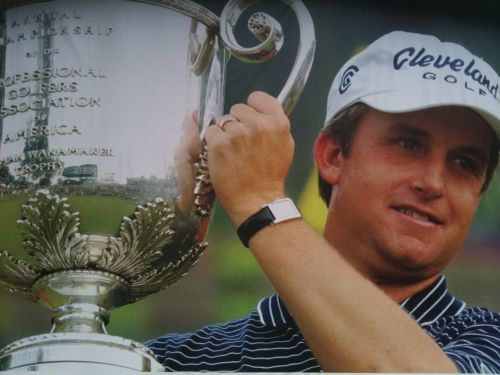www.golfbytourmiss compares the last two U.S. PGA Championships staged at the Atlanta Athletic Club and we discover they have provided polar opposite results.
Larry Nelson scored as easy, drama-free victory in 1981 while fellow American David Toms walked a tightrope when he won in dramatic fashion in 2001.
Nelson, who grew up in nearby Arcworth, won the first of his three Major championships with a four-shot victory over Fuzzy Zoeller. But the breakthrough may not have taken place had it not been for a rain delay during the first round that occurred about the time Nelson finished the ninth hole.
“That gave me the opportunity to go to the practice putting green and I figured something out – I don’t even remember what it was – but I putted well for the rest of the week,” Nelson recalled.
“That was probably the difference in me winning the Championship.”
When play resumed, Nelson played the back nine in 3-under and finished with a 70.
He then put together back-to-back 66s that allowed him to start the final round with a four-shot lead.
No one ever got closer than three strokes and Nelson strolled to a trouble-free 71 to seal victory.
Toms, a native of Louisiana, was more theatrical in winning his only Major title.
He held a share of the lead after the second round and was the outright leader going into the final round thanks to a third day 65.
Toms never gave up the lead on Sunday, although Phil Mickelson tied him several times.
Approaching the final hole, Toms found himself with a 209-yard approach to the water-front 18th green.
Earlier in the week, Toms had stated he would not hesitate to lay-up on the long par 4 in such a situation rather than potentially fall victim to the water.
Even in the final round, Toms said he would be content to live or die with his short game.
So faced with that exact dilemma on Sunday, Toms played short of the water, and trusted his short game when he grabbed a wedge and put the ball to within 12-feet of the flag.
Knowing he must make the putt or face Mickelson in a play-off, Toms rolled it in.
“I turned to my caddy and said: ‘These are the ones you’re supposed to make to win a Major, especially your first one,’” Toms recalled.
“I took a couple of deep breaths, and to be honest, I was not shaking.”
Toms shot all four rounds in the 60s, including a last day 69, and set a record for the lowest score for a Major championship of 15-under par 265.
“I’m somewhat shocked that it’s actually happened to me,” said Toms. “I’m very proud fo the way I played and the way I finished it off.”
One headline in the next day’s paper said it all: “Major Toms”.
COURSE CHANGES SINCE 2001
1. Players contesting the 93rd US PGA will find a longer course. A renovation spearheaded by architect Rees Jones and completed in 2006 has seen the course stretched to 7,486 yards but will still play to a par 70.
2. The fairways are narrower, firmer and faster. The Athletic Club switched to Diamond Zoysia, a surface that Ken Magnum, the director of golf courses and grounds since 1988, says the ball will roll about nine on the Stimpmeter. The fast fairways will ensure players will have difficulty in keeping their drives on the short stuff.
3. The rough was changed to Tifton 10 Bermuda, which will offer a darker, more colourful contrast to the fairways. It will also present the player with a different challenge, since a ball will now be less likely to sink to the bottom of the rough and could require more inventive shot-making.
4. The bunkers were deepened and fairway bunker were moved to accommodate today’s longer players. The bunkers were moved 10 – 40 yards farther down the fairways, most of them in the 280 – 340 yards compared to 240 -250 yards in 1981.
5. The bent grass greens were replaced with a new strain of Bermuda known as Champion Utradwarf. It is expected to produce firmer greens that will be more difficult to hold.
Four tees were lengthened to add another 273-yards to the design.
But not all changes were made with a penal motive as the No. 1 tee was backed up to accommodate crowd flow.
Officials believed the Highlands Course, that hosted the 1976 U.S. Open, had been toughened up in order to keep pace with the Atlanta Athletic Club’s Riverside Course, the venue for the 1990 U.S. Women’s Open which was renovated in 2003.
HOLES 15 to 18 the Most Challenging.
15th – The par three, 15th hole was aced from 243-yards by David Toms in the third round in 2001 and is the longest hole-in-one in a Major Championship.
A new tee gives officials the option to play it at 260-yards. The 15th was the second toughest hole in 2001.
16th & 17th – The par four 16th is 485-yards while the 17th a 210-yard par three was the third-hardest in 2001.
18th – The final hole, ranked the toughest in 2001, was tweaked, too. From the tee a player may now see the lake, which was brought 10-15 yards farther to the right and into the fairway. The par 4 will play 500-plus yards to the green fronted by water. In 2001, Toms made the decision to lay up on the 72nd hole and trust his wedge and putter to win the Championship.
The Atlanta Athletic Club now joins Southern Hills, Oakmont, Oakland Hill and Firestone, as the only courses to host three U.S. PGA Championships.




